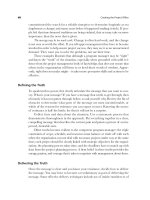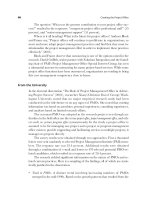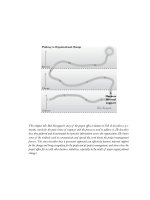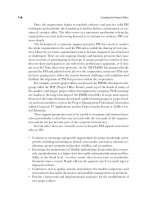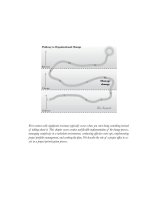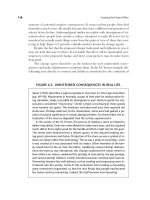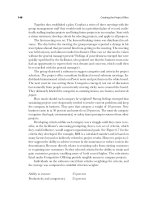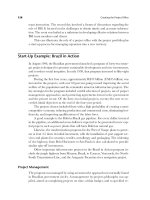Tài liệu Creating the project office 33 pptx
Bạn đang xem bản rút gọn của tài liệu. Xem và tải ngay bản đầy đủ của tài liệu tại đây (142.11 KB, 11 trang )
Establish sense of urgency—
clear danger
Lead organizational change
Create guiding coalition—
powerful forces
Develop vision and strategy—
focus
Manage the change—
short-term wins, broad-based
action, consolidate gains
Develop broad-based action—
keep moving, implementing
Make change stick—
new PBO culture
The tale we tell
Communicate the change vision—
tell the tale
Staff and operate—
In or out?
Change
Refreeze
Unfreeze
• know current problems
• add value to the organization
• compare to the best
• describe desired future state
• be organizational change agent
• plan organizational change
• become project-based enterprise
• implement a project office as
organizational change
• understand politics
and power
• build sponsorship
and a political plan
• speak truth to power
• operate across
organizations
• develop right concept
• communicate and build
commitment
• gain insights from others
• review case studies for
examples
• find where it hurts
• organize believers
• get the word out
• sustain the path
• manage complexity
• conduct program start-up process
• implement consistent methodology
• sustain balance
• practice project portfolio management
• review case studies—work the plan
• establish infrastructure:
• people, processes,
and tools
• manage stakeholders
• evolve capabilities
and capacity
• review case studies
• identify competence
• develop program managers
• operate and work together
• define roles and responsibilities
• increase breadth and depth of PM
• focus on framework: leadership,
learning, means, motivation
• apply critical success factors (9)
• reach the tipping point
• invoke agents of change:
people, process, environment
• focus on core
• act organically
• use templates
Leading
Organizational
Change
to PBO
REFERENCES
Bailey, F. G. Morality and Expediency: The Folklore of Academic Politics. Chicago: Aldine, 1977.
Berger, L. A., and others. The Change Management Handbook: A Road Map to Corporate Transforma-
tion. New York: Irwin, 1994.
Berger, L. A., and others. Deengineering the Corporation: Leading Growth from Within. Pennsylvania:
Haverford Business Press, 1998.
Berger, P. L., and Luckmann, T. The Social Construction of Reality. New York: Anchor Books,
1966.
Birkinshaw, J., and Hood, N. “Unleash Innovation in Foreign Subsidiaries.” Harvard Business
Review, Mar. 2001, pp. 131–137.
Block, P. The Empowered Manager: Positive Political Skills at Work. San Francisco: Jossey-Bass,
1991.
Block, T. R. “The Seven Secrets of a Successful PMO.” PM Network Magazine, 2001.
Block, T. R., and Frame, J. D. “Today’s Project Office: Changing Attitudes.” PM Network
Magazine, Aug. 2001, pp. 50–53.
Bucero, A. “Implementing the Project Office, a Real Case of Innovation.” Paper presented
at the IPMA Symposium, Stockholm, June 2001.
Bucero, A. “Seamless Transitions: Managing Change on Difficult Projects.” PM Network
Magazine, Mar. 2002.
Buckingham, M., and Clifton, D. O. Now, Discover Your Strengths. New York: Free Press, 2001.
Camus, A. “The Myth of Sisyphus.” In The Myth of Sisyphus and Other Essays. New York:
Vintage Books, 1991. (Original work published 1942.)
Cohen, D. J., and Graham, R. J. The Project Manager’s MBA: How to Translate Project Decisions into
Business Success. San Francisco: Jossey-Bass, 2001.
299
Cohen, D. J., and Kuehn, J. “Navigating Between a Rock and a Hard Place: Reconciling
the Initiating and Planning Phases to Promote Project Success.” Paper presented at PMI
Symposium, New Orleans, 1996.
Cohen, D. J., and Kuehn, J. “Value-Added Project Management: Doing the Project Right Is
Not Enough.” Paper presented at PMI Symposium, 1997.
Cooper, R. Portfolio Management for New Products. Reading, Mass.: Addison-Wesley, 1998.
Crawford, J. K. (ed.). The Strategic Project Office: A Guide to Improving Organizational Performance.
New York: Dekker, 2001.
Dai, X. C. “The Role Of Project Management Office In Achieving Project Success.” Un-
published Ph.D. dissertation, Department of Management Science, School of Business
and Public Management, George Washington University, 2001.
Dinsmore, P. C. “Cookbooks, Restaurants and Enterprise Project Management.” In Winning
in Business with Enterprise Project Management. New York: AMACOM, 1998.
Dinsmore, P. C. “Project Office: Does One Size Fit All?” PM Network Magazine, Apr. 2000,
pp. 27–29.
Dinsmore, P. C. “It’s All About Power.” PM Network Magazine, May 2001, pp. 27–28.
Dinsmore, P. C. “Project Offices: Best Practices Help Ride Out the Storm.” PM Network
Magazine, May 2002a, p. 24.
Dinsmore, P. C. “Sixteen Reasons Not to Implement a Project Office.” PM Network Magazine,
Feb. 2002b.
Druskat, V. U., and Wolff, S. B. “Building the Emotional Intelligence of Groups.” Harvard
Business Review, Mar. 2001, pp. 80–90.
Englund, R. L. “Linking Strategy and Portfolio at Front End.” PDMA Visions, July 2000,
pp. 22–23.
Englund, R. L., and Graham, R. J. “Speaking Truth to Power” Today’s Engineer, Summer
1998, pp. 16–20.
Englund, R. L., and Graham, R. J. “From Experience: Linking Projects to Strategy.” Journal
of Product Innovation Management, 1999, 16, 52–64.
Englund, R. L., and Graham, R. J. “Implementing a Project Office for Organizational
Change.” PM Network Magazine, Feb. 2001, pp. 48–50.
Gallwey, W. T. The Inner Game of Work. New York: Random House, 2000.
Gladwell, M. The Tipping Point: How Little Things Can Make a Big Difference. Boston: Back Bay
Books, 2002.
Graham, R. J., and Englund, R. L. Creating an Environment for Successful Projects: The Quest to
Manage Project Management. San Francisco: Jossey-Bass, 1997.
Graham, R. J., Englund, R. L., and Cohen, D. J. “Are You Ready for World Class Project
Management?” Paper presented at PMI Symposium, Houston, 2000.
Kennel, J., “Creating a Project Management Culture in a Global Corporation.” Paper pre-
sented at Project World conference, Santa Clara, Calif., 1996.
Kerzner, H. Strategic Planning for Project Management Using a Project Management Maturity Model.
New York: Wiley, 2001.
Kleiner, A. “The Dilemma Doctors.” Strategy & Business, 2001, 23, 74–85.
Kotter, J. P. Leading Change. Boston: Harvard Business School Press, 1996.
Kuhn, T. S. The Structure of Scientific Revolutions. Chicago: University of Chicago Press, 1996.
Larson, E. W., and King, J. B. “The Systematic Distortion of Information: An Ongoing
Challenge to Management.” Organizational Dynamics, 1996, 24(3), 49.
300 References
Levy, P. F. “The Nut Island Effect: When Good Teams Go Wrong.” Harvard Business Review,
Mar. 2001, pp. 51–59.
Lewin, R., and Regine, B. The Soul at Work: Listen, Respond, Let Go; Embracing Complexity Science
for Business Success. New York: Simon & Schuster, 2000.
McMahon, P., and Busse, E. “Surviving the Rise and Fall of a Project Management Office.”
Paper presented at the Project Management Institute Annual Seminars & Symposium,
Nashville, Tenn., Nov. 1–10, 2001.
Miller, C. PMDA Visions, Apr. 2001, p. 13.
Moore, G. A. Living on the Fault Line: Managing for Shareholder Value in the Age of the Internet. New
York: HarperBusiness, 2000.
Naisbitt, J. High Tech High Touch: Technology and Our Search for Meaning. New York: Broadway
Books, 1999.
Pinto, J. K. Power and Politics in Project Management. Upper Darby, Penn.: Project Management
Institute, 1996.
Project Management Institute Standards Committee. A Guide to the Project Management Body of
Knowledge (PMBOK® Guide). Upper Darby, England: Project Management Institute, 2000.
Saint-Exupéry, A. de. The Little Prince (K. Woods, trans.). Orlando, Fla.: Harcourt Brace,
1971. (Original work published 1943.)
Sandberg, J. “Understanding Competence at Work.” Harvard Business Review, Mar. 2001,
pp. 24–28.
Schneidmuller, J., and Balaban, J., “From Project Management Council to Center of Excel-
lence: The Journey Continues.” Paper presented at PMI Symposium, Houston, 2000.
Senge, P. The Dance of Change: The Challenge of Sustaining Momentum in Learning Organizations.
New York: Currency Doubleday, 1999.
Senge, P., and Kim, D. “The Cycle of Knowledge Creation.” Systems Thinker, May 1997.
Spicer, E. H. Human Problems in Technological Change, a Casebook. New York: Russell Sage Foun-
dation, 1952.
Storeygard, B. “Growing the Professional Project Leader.” Paper presented at PMI Sym-
posium, New Orleans, 1996.
Storeygard, R. “The Project Leader Competency Model.” 3M internal document released
at the PMI Symposium, New Orleans, 1996, as part of the white paper “Growing the
Professional Project Leader.”
Storeygard, R. “Organizational Deployment of Project Management: The Next Big Aha for
Corporate Project Leaders.” In J. Knutson (ed.), Project Management for Business Professionals:
A Comprehensive Guide. New York: Wiley, 2001.
Toney, F. The Superior Project Manager. New York: Dekker, 2002.
Wheatley, M. J. Leadership and the New Science: Learning About Organization from an Orderly Universe.
San Francisco: Berrett-Koehler, 1994.
Woldhek, S. “Zealot Profile.” Strategy & Business, 2001, 23, 61.
References 301
INDEX
303
A
Advance Brazil, 160, 161
Advocates, 13
Alighieri, D., 7, 8, 28
American Productivity & Quality
Center, 65
Araguaia-Tocantins river navigation
project (Brazil), 158
Asians, 233
AT&T, 9, 10, 21, 22, 255; Informa-
tion Systems, 255
Attila approach, 15, 288
Australia, 49, 234
Australian Stock Exchange, 238
Aviano 2000 Program Management
Office (United States Air Force):
“Approach for Aviano 2000
Project Managers,” 201, 202;
communications in, 207–208;
course of action for, 200–203;
and leading change to processes,
204–205; lessons learned from,
210–215; and people develop-
ment, 205–207; and program
assessment, 209–210; Program
Management Plan (PMP), 205,
206; results, 208–209; sense of
urgency for, 199–200; sponsor-
ship in, 203–204; vision for, 198
B
Bailey, F. G., 34
Balaban, J., 9, 21, 22
Balkans, 200, 208
Battelle Memorial Institute (Rich-
land, Washington), 101–103;
Project Management Division,
102
Beer, V., 16
Benchmarking, 45–46
Berger, L. A., 63, 256
“Big Dig” (Boston), 37
Birkinshaw, J., 161
Block, P., 63
Block, T. R., 97, 98
Bolivia-Brazil gas pipeline, 158, 159
Brazil in Action program, 158, 160,
161
Broad-based action, 26–27
Brutus, 37
Bucero, A., 167–195, 222, 280
Buckingham, M., 223
Bull, S., 145, 230–232
Busse, E., 55, 56, 146, 147
C
California, 4, 282
Camus, A., 130–131
Canada, 230–232
Cartwright, C., 101
Center for Business Practices (CBP;
PM Solutions), 43
Change: adapting to, 79; causing, 17,
25–28; creating conditions for,
16–17, 18–25; organizational, ver-
sus reorganization, 14–15; path-
way to, 2, 6; sustaining, 17, 28–29
Change process: implementing
project office as, 18–29; overall
organizational, 16–17; for
project-based organization, 30;
roles in, 13
Channel Tunnel, 37
Chaos theory, 163
Charles Schwab & Company, Inc.,
60
Chevron Corporation, 19, 45, 273,
274; Project Development and
Execution Process (CPDEP),
19, 45, 273; Project Resources
Company, 273
ChevronTexaco, 273
Chief Project Officer (CPO) con-
cept, 87–88
Clear danger, developing: and prob-
lems with minimizing cost as
project office goal, 36–38; and
spinning wheels, 35–36. See also
Urgency, creating sense of
Clifton, D. O., 223
Clooney, G., 219
Coalition, guiding: building, 53–56;
and business case for developing
high-level commitment, 65–66;
in implementing project office,
21–22; and politics, 56–58; and
power, 58–60; recruiting and
management of, 73–79; and
speaking truth to power, 66–73;
and sponsorship, 60–64
Cohen, D. J., 19, 40, 45, 46, 123,
221, 249, 251, 253, 254, 256,
258, 259, 273
Commitment: business case for
developing high-level, 65–66;
gaining, 77
“Communications Project Assess-
ment Tool (COMPASS)” (Con-
struction Industry Institute), 207
Compaq, 189
Complexity, managing, 130–132
Construction Industry Institute, 207
Contagiousness, 279
Cooper, R., 142
Core, focus on, 280–281
Crawford, J. K., 45, 239–240
Crawford, L., 93
Creating an Environment for Successful
Projects: The Quest to Manage
Project Management (Graham and
Englund), 210–211
CS Energy, 93
Cupertino, California, 104
Customer optimizer, 220
D
Dai, X. C., 36, 50, 51, 98
Dante. See Alighieri, D.
304 Index
deLeon, J. D., 113
Dell Computer, 14–15
Deloitte Touche Tohmatsu, 239
Diaz deLeon, J., 113
Dinsmore, P. C., 49, 58
Don Quixote, 129
Donner party, 4
Druskat, V. U., 134
E
eBay, 14–15
Embraer (Brazil), 10
Emotional intelligence, 134
Empowerment, sins of (Graham),
71, 72
England, 67–68
Englund, R. L., 10, 14, 46, 130,
144, 147, 211, 241, 252, 258
Entropy, 133
Ericsson, 100, 161
Ericsson Australia, 93, 99–101
Executive Initiative Institute (Scotts-
dale, Arizona), 88
EXFO (Expertise in Fiber Optics),
142, 145, 230–232
Externalization, 256
F
Force field analysis, 71
Ford Motor Corporation, 21
Frame, J. D., 98, 220
G
Gains, consolidating, 27–28
Galileo, 67
Gallup organization, 223
Gallwey, W. T., 140
Gartner Group, 45
George Washington University, 98
Germany, 200
Gladwell, M., 278–280
Global organization, 99–101
Goal definition, 134
Good, Bad, and the Ugly (cinema),
140
Goodman Fielder Limited, 93; Divi-
sional Program Office at, 235–
238; Group Program Office at,
234–235, 238; project manage-
ment in action at, 238–239
Graham, R. J., 10, 14, 25, 40, 46,
71, 123, 130, 144, 147, 211,
221, 241, 251–253, 258, 259
Greenleaf, R., 121
Griffith, D., 98
Guiding coalition. See Coalition,
guiding
H
Hampden-Turner, 233
Harmon, K., 60
Henrichs, D., 281
Hewlett-Packard, 70, 71, 281; Con-
sulting Organization (HPC), 65,
167–195, 222, 280; Global Pro-
gram Management Office, 189;
Information Technology Group
(ITG), 103–106; Knowledge
Management Initiative, 188–189;
merger with Compaq, 189; Pre-
cision Architecture (HP-PA),
103; Project Management Ini-
tiative, 10, 22, 23, 60, 64, 69,
75, 136, 188–189, 241–243;
Quality initiative, 188–189; Re-
duced Instruction Set Comput-
ing (RISC), 103; Spectrum
Program Management Group,
61, 103–106; Strategic Manage-
ment Group, 69
Hewlett-Packard Consulting Orga-
nization (HPC): critical success
factors at, 173–174; document
management system, 169, 185–
186; and geographic PMO re-
sponsibilities, 191–192; and
global PMO responsibilities,
192; mission and objectives of,
168–171; plan for, 174–178;
PMO evolution at, 188–193;
PMO meetings at, 172–173;
and quality assurance, 178–179;
scope of, 171–174; stakeholder
analysis, 179–181; support and
sponsorship in, 182–184; and
value added, 184–188
High Tech High Touch (Naisbitt), 135
Hood, N., 161
Index 305
Human Systems Global Network,
46, 49, 50, 69
Human Systems Knowledge Net-
works, Pacific Rim, 93
I
IBM, 10, 233, 255; Project Man-
agement Center of Excellence
(PMCOE), 10, 85–89, 92, 137
Inferno (Dante), 7
Innovation Focus Inc., 284
Integrated curriculum viewpoint,
227
Interactive optimizers, 220
Italian Defense General Staff, 197,
215
Italian Red Brigades, 215
Italy, 197, 204, 207
J
Japan, 67
Julius Caesar (Shakespeare), 37
K
Kennel, J., 21, 22, 26
Kerzner, H., 239–240
Kim, D., 282
King, J. B., 66
Kleiner, A., 233
Kosovo Air Campaign, 208, 214
Kotter, J. P., 18, 28
Kuehn, J., 19, 45, 273
Kuhn, T. S., 66
L
L
2
M
2
(Leadership, Learning,
Means, and Motivation) frame-
work, 253, 254, 257, 258, 274
LaGassey, G. (United States Air
Force), 197–217
Lambert, L. R., 102
Larson, E. W., 66
Law of the Few, 278, 279
Levy, P. F., 161
Lewin, R., 16, 132
Little Prince, The (Saint Exupéry), 131
Living on the Fault Line (Moore), 280
Lucent Technologies, 93
Luckmann, T., 256
M
Madrid, 170, 222
Maximizing Project Performance
(MPP), 252; and five factors to
block alignment and mobiliza-
tion of project system, 254; on-
line program, 254
McMahon, P., 55, 56, 146, 147
Megatrends (Naisbitt), 135
Microsoft Project, 186
Miller, C. W., 284
Mission statement, 134
Monteiro Corrêa, L., 159
Moore, G. A., 280
Morality and Expediency (Bailey), 34
Morton, D., 22
Moses, 65–66
N
Naisbitt, J., 135
National Family Agriculture Pro-
gram (Brazil), 159
NCR, 10, 21–23, 26
New Zealand, 234
Nohria, N., 16
North Atlantic Treaty Organization
(NATO), 197–199, 205, 207
North-South Transmission Line
(Brazil), 158, 159
Nut Island sewage treatment plant
(Boston Harbor), 161, 162
O
Objectification, 256
Ocean’s Eleven (cinema), 219
Optus, 93
Oregon Trail, 4, 282
Organizational change: implement-
ing project office in process of,
18–29, 146–147; leading, 7–9;
and organizational life cycles,
11–13; overall process of, 16–17;
and project office movement,
9–11; versus reorganization,
14–15; roles in, 13
Organizations: changing project
system in, 251–255; describing
desired, 46–49; and dynamics of
organizational culture, 255–257;
operating across, 73–79; project-
based change process for, 30
P
Pacific Northwest Laboratory
(PNL), 101–103
Pacific Rims Networks, 93
PERT charts, 9
Philadelphia, 252
Pinto, J. K., 57, 61, 64
PM Network, 97
PM Solutions, 43, 240; Center for
Business Practices (CBP), 43;
Top 500 Project Management
Benchmarking Forum, 46
Politics: and guiding coalition,
56–58; and political acumen,
20–21; and political manage-
ment plan, 61–62
Port of Suape, 158, 159
Portfolio management. See Project
portfolio Management
Power: and guiding coalitions,
58–60; speaking truth to,
66–73
Power and Politics in Project Management
(Pinto), 57
Power of Context, 278, 279
Prioritization: matrix for, 154; work-
sheet for project, 153
Project Environment Assessment
Tool (PEAT), 46, 69, 252; com-
munication and information
systems support factor in,
268–270; customer and end-
user input factor in, 264–265;
economic value support factor
in, 271–274; organization sup-
port factor in, 270–271; project
performance support factor in,
267–268; project planning sup-
port factor in, 262–264; project
team support factor in, 265–267;
strategic emphasis factor in,
258–260; upper management
support factor in, 260–262
Project Management Body of Knowledge
(PMBOK; Project Management
Institute), 137, 190, 202, 209,
210, 251, 253
Project Management Center of
Excellence (PMCOE) concept,
85–87. See also under IBM
Project Management Initiative. See
under Hewlett-Packard
Project Management Institute, 93,
137, 202, 224; Project Manage-
ment Office Special Interest
Group, 98
Project Management Office (PMO)
concept, 87; approach to propos-
ing and implementing, 171; im-
plementation plan for, 175
Project Management Special Inter-
est Group (PMSIG). See under 3M
Project office: communicating and
building commitment for, 92–93;
and creating conditions for,
18–29; design variables, 90; im-
plementing, as organizational
change process, 18–29; and
making change happen, 25–28;
and making change stick, 28–29;
movement, 9–11; refining con-
cept of, 288; review, 286–289;
survey information on, 93–99;
various names for, 83–89; vision
and strategy for, 89–91
Project office, implementation: Brazil
in Action example of, 158–161;
facilitation role for, 147–152;
and linking process, 143–146;
and managing complexity,
130–132; methodology for,
136–137; and organizational
approaches, 146–147; and pro-
gram start-up process, 132–136;
sustaining balance in, 139–141;
Timbrasil example of, 155–158;
and unintended consequences
of change, 137–139; and work-
ing the plan, 161–162
Project office, staffing and operat-
ing: and competence, 220–223;
and cultural effects, 233; and
EXFO approach to new prod-
uct development, 230–232; and
funding, 242–243; and Hewlett-
306 Index
Packard Program Management
Initiative, 241–242; and inte-
grated project management at
3M, 225–230; and maturity,
239–240; process steps and cri-
teria for, 222; and staff infec-
tion, 233–234; and structure at
Goodman Fielder, 234–239;
and working together, 232–234;
and zeal, 223–224
Project offices, cases of: and Ericsson
Australia, 99–101; and Hewlett-
Packard Spectrum Program,
103–106; and Pacific Northwest
Laboratory (PNL), 101–103
Project portfolio management, 42,
141–143; aligning projects with
strategic goals through, 285–286;
and portfolio tools, 152–155
Project Support Office (PSO) con-
cept, 85
Purpose statement, 134
Q
Quaker approach, 14, 15, 216, 287,
288
R
Reality, social construction of, 256
Red Brigades (Italy), 215
Reed, V., 4
Regine, B., 132
Relationship: establishing, 77–78;
maintaining, 78–79; prepara-
tion for, building, 75–77
Reorganization, organizational
change versus, 14–15
Resitech, 93
Rio de Janeiro, 155
Road and Traffic Authority of New
South Wales, 93
“Role of Project Management Of-
fice in Achieving Project Suc-
cess, The” (Dai), 98
Rowe, S., 235–237
S
Saint-Exupéry, A. de, 131
Sandberg, J., 220
Schneidmuller, J., 9, 21, 22
Senge, P., 141, 282
Sequential optimizers, 220
Servant leadership, 121
Shakespeare, W., 33, 37
Short-term wins, 25–26
Sisyphus, 130–131, 289
Six Sigma programs, 121, 265
Social construction of reality, 256
Socialization, 256
Solutions Integration, 98
Sotério di Oliveira, M., 159
Southwest Airlines, 14–15
Speak truth process: and building
coalitions, 66–68; and defining
truth, 68; and delivering truth,
68–70; implementation of,
70–72; summary of, 74
Spicer, E. H., 138
Sponsors, 182–184
Sponsorship, 60–64
Stakeholders: compass to identify,
62; and creating stakeholder
strategy, 63–64; diagnosis of,
63
Standardized quality improvement
process, 179
Star Alliance, 10
Steel Axes for Stone Age Australians
(Spicer), 138
Stickiness Factor, 278, 279
Storeygard, B., 109–123, 227, 228
Strategic Management Group
(SMG), 46, 249, 252, 254
Strategy, developing, 22–23
Survey information: from Australia,
93–96; from United States,
97–98; from university, 98–99
Surviving the Rise and Fall of a Project
Management Office (McMahon
and Busse), 55
Sydney, Australia, 93
Sydney Water Corporation, 93
System Architecture Lab, 104
Systems Technology Group, 77
Systems Thinker, The (Pegasus Com-
munications), 282
T
Targets, 13
Technologically Intoxicated Zone, 135
Index 307
Telecom Italia Mobile (TIM), 155;
Business Support and Integra-
tion (BSI), 155, 158; and Tim-
brasil, 155–158
Telestra, 93
Template: for creating an environ-
ment for successful projects,
295–297; for implementing a
project office for organizational
change, 292–294
Terra Incognita, 3, 4
Texaco, 273
Texas Instruments, 60
Theory E, 16
Theory O, 16
3M, 10, 109–123, 240; fit of project
office with major organizational
change at, 121–122; future of
project management at, 119–
121; integrated project manage-
ment at, 225–230; Learning
Center, 115, 223–226; prelimi-
nary efforts to establish project
management at, 111–112;
Project Leader Competency
Model, 113, 115, 226, 228, 229;
Project Leadership Curriculum,
115, 226–228; Project Manage-
ment Maturity model, 113, 114,
122; Project Management Spe-
cial Interest Group (PMSIG),
10, 21, 112–114, 118, 122, 123;
Project Management Temple,
116–117, 122; Project Office
Implementation Kit (POIK),
119, 122; recognizing need for
project management at, 109–
111; sustainment of movement
at, 117–119
Timbrasil, 155–158; sample plan of
record, 156–157
Tipping point, 278–280
Toney, F., 88
Top 500 Project Management
Benchmarking Forum (Milwau-
kee, Wisconsin), 46, 87–88
Total Quality Management, 265
Triple constraints, 36
Trompenaars, 233
Truth: defining, 68; delivering,
68–70; and implementing speak
truth process, 70–73; and sum-
mary of speak truth process, 74
U
United Airlines, 10
United States Air Force (USAF):
Aviano Program Management
Office (PMO), 197–217; and
U.S. Air Forces in Europe
(USAFE), 199, 203, 204
United States Army, 207
United States Department of
Energy, 101
United States Navy, 197, 199, 204,
207
University Olympics, 216, 217
Urgency, creating sense of: and
adding value to the organization,
38–45; and arguments against
project office, 49–51; and bench-
marking organization’s project
management practices, 45–46;
and describing desired organiza-
tion, 46–49; and developing a
clear danger, 34–38
V
Value added, 38–45; and achieving
strategy, 42–43; and building
competitive advantage, 43; and
developing value proposition,
42–44; and increasing return
on investment (ROI), 43; and
projects as investments, 40–42;
and thinking outside box, 39
Vicious loop, 143
Virgil, 7
Virtuous loop, 144
Vision, 22–23; communicating,
24–25; defining driving, 24–25
Volvo, 220
W
Wheatley, M. J., 131
Wheelwright, S., 142
Willits, G., 225
Winter Olympics (2002; Salt Lake
City), 76
Woldhek, S., 223
Wolff, S. B., 134
World Wide Fund for Nature
(Netherlands), 223–224
Y
Y2K, 146, 238–239
Yellow Pages, 255
Yir Yoront, 138
This page is a continuation of the copyright page.
• PM Network, Project Management Institute, Inc., April 2000, Vol. 14, Number 4.
© 2000 Project Management Institute, Inc. All rights reserved. Material from
this publication has been reproduced with the permission of PMI.
• PM Network, Project Management Institute, Inc., February 2001, Vol. 15, Num-
ber 2. © 2001 Project Management Institute, Inc. All rights reserved. Material
from this publication has been reproduced with the permission of PMI.
• PM Network, Project Management Institute, Inc., May 2001, Vol. 15, Number 5.
© 2001 Project Management Institute, Inc. All rights reserved. Material from
this publication has been reproduced with the permission of PMI.
• PM Network, Project Management Institute, Inc., February 2002, Vol. 16, Num-
ber 2. © 2002 Project Management Institute, Inc. All rights reserved. Material
from this publication has been reproduced with the permission of PMI.
• PM Network, Project Management Institute, Inc., May 2002, Vol. 16, Number 5.
© 2002 Project Management Institute, Inc. All rights reserved. Material from
this publication has been reproduced with the permission of PMI.
The service and trademarks “PMI” and the PMI logo, and the trademarks
“PMBOK” and “PM Network” are registered marks of the Project Management
Institute, Inc., in the United States and/or other nations.
